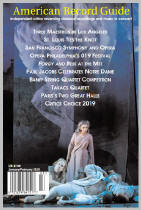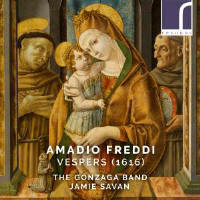Texte paru dans: / Appeared in: |
|
|
Outil de traduction ~ (Très approximatif) |
|
|
Reviewer: Catherine
Moore
Amadio Freddi (c 1580-1643)
began his musical career as a singer and later held maestro di cappella
positions at cathedrals in Treviso, Vicenza, and Padua. A prolific composer,
he was certainly familiar with the grand Venetian style of writing; and this
program shows how he was adept at using a chamber-sized group of varied
voices and instruments to create “an illusion of more lavish forces,
evocative of the polychoral tradition”. In the booklet notes ensemble
director Jamie Savan recognizes Freddi as an innovator who fused “elements
of the nascent trio sonata with the concertato motet [anticipating] a
pattern that was to become one of the hallmarks of the Venetian style in the
1620s”. The Gonzaga Band is also expert at making the most of their six
singers (SCtCtTTB) and three instruments (violin, cornett, organ). For
instance, the nice flow and energy in ‘Ave Maris Stella’ is colorfully
animated by having cornett play the second violin part and the organ’s bass
reed stop play the bassoon part. The performances are good, especially the
ones with larger forces as compared to the solo motets. There’s nice
interplay in ‘Nisi Dominus’ as voices and instruments criss-cross their
melodies. The organ here is a Hauptwerk Virtual Pipe Organ, using samples from a specific 18th-Century instrument in Slovenia. Whether this type of digital organ software is a positive step for record producers and performers is a topic for another time. Notes,
texts, translations. I liked the same ensemble’s “Venice 1629” (Resonus
10218, N/D 2018: 188). | |
|
|
|
|
Cliquez l'un ou l'autre
bouton pour découvrir bien d'autres critiques de CD |
|




